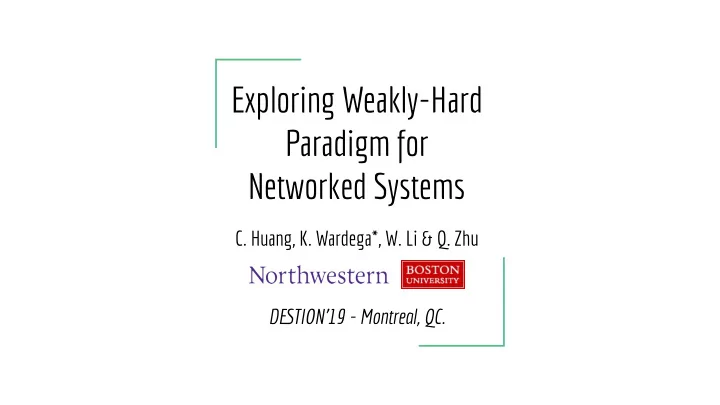

Exploring Weakly-Hard Paradigm for Networked Systems C. Huang, K. Wardega*, W. Li & Q. Zhu DETTION’19 - Montreal, QC.
Background The design of systems that work Timing and Failure 2
Hard Real-Time Model WCET Analysis Deadlines Scheduling Characterize the system. Plan everything. Give each task a deadline. How bad can it get, exactly? Power, resources, period. Can I even do this? Is it just hard? Or impossible? 3
Firm/Sofu Real-Time Model pWCET* Analysis Distributions* Scheduling Characterize the system. Plan everything. Assign each task a distribution*. How bad can it get, probably*? Power, resources, period. Is this useful for my application? 4
Timing Constraints vs Guarantees Hard Firm Soft 5
Timing Constraints vs Guarantees Hard Firm Soft Trace guarantee Set of traces guarantee (deterministic) (probabilistic) 6
Timing Constraints vs Guarantees Hard Firm Soft ? Trace guarantee Trace guarantee Set of traces guarantee (deterministic) (deterministic) (probabilistic) 7
Can I get trace guarantees if computing WCETs is hard? How about introducing bounded non-determinism ? 8
Meet Consecutive Meaning 1 ⟨ m,K ⟩ Meet at least m deadlines of every K 2 ⟪ m,K ⟫ Meet at least m consecutive deadlines in every K 3 ( m,K ) Miss no more than m deadlines of every K 4 Miss no more than m consecutive deadlines (( m,K )) in every K 9
Meet Consecutive Meaning 1 ⟨ m,K ⟩ Meet at least m deadlines of every K 2 ⟪ m,K ⟫ Meet at least m consecutive deadlines in every K 3 ( m,K ) Miss no more than m deadlines of every K 4 Miss no more than m consecutive deadlines (( m,K )) in every K 10
Weakly-Hard Real-Time Model “Analysis” “Deadlines” Scheduling Characterize the system. Give each task a deadline. Plan everything. pWCET or ( m,K )-type Deadline misses are bounded. Power, resources, period. constraints. Traded probabilities for Easier than analysis during bounded non-determinism. design of a Hard Real-Time Potentially higher System. performance! Still get trace guarantees! 11
Applications of the Weakly-Hard Model Weakly-Hard Constraints Energy-Constrained RTS RT Linear Control Methodology introduced. Maximize performance within Reachability analysis via (Bernat, IEEE Trans. Comp.) energy limits under Weakly-Hard bounded time safety constraints. (AlEnawy, RTSS) verification. (Duggirala, RTSS) 2002 2008 2019 2001 2005 2015 Controller Area Networks Multimedia RT Nonlinear Control Weakly-Hard vs Scheduling for a multimedia Sufficient conditions for safety overly-pessimistic Hard service under overload analysis of weakly-hard control. real-time. (Broster, ECRTS) conditions. (Wu, UMEDIA) (Huang, HSCC) 12
Applications of the Weakly-Hard Model Embedded Systems Weakly-Hard Constraints Energy-Constrained RTS RT Linear Control Methodology introduced. Maximize performance within Reachability analysis via (Bernat, IEEE Trans. Comp.) energy limits under Weakly-Hard bounded time safety constraints. (AlEnawy, RTSS) verification. (Duggirala, RTSS) 2002 2008 2019 2001 2005 2015 Controller Area Networks Multimedia RT Nonlinear Control Weakly-Hard vs Scheduling for a multimedia Sufficient conditions for safety overly-pessimistic Hard service under overload analysis of weakly-hard control. real-time. (Broster, ECRTS) conditions. (Wu, UMEDIA) (Huang, HSCC) 13
Applications of the Weakly-Hard Model Not an Embedded System 20?? Networked systems Weakly-Hard Constraints Energy-Constrained RTS RT Linear Control Methodology introduced. Maximize performance within Reachability analysis via (Bernat, IEEE Trans. Comp.) energy limits under Weakly-Hard bounded time safety constraints. (AlEnawy, RTSS) verification. (Duggirala, RTSS) 2002 2008 2019 2001 2005 2015 Controller Area Networks Multimedia RT Nonlinear Control Weakly-Hard vs Scheduling for a multimedia Sufficient conditions for safety overly-pessimistic Hard service under overload analysis of weakly-hard control. real-time. (Broster, ECRTS) conditions. (Wu, UMEDIA) (Huang, HSCC) 14
Mobile Cloud Cloud Robotics Connected Vehicles IoT Consensus Reliability QoS Control Reachability Flooding Stability 15
WCET-based analysis of networked systems is likely impossible. 16
Related Work (Ahrendts, ECRTS 2018) Permanent (Hao, HPSR 2004) node Scheduling failures Fault Weakly-Hard Tolerance Models Transient Control disturbances stability (Zhang, RTAS 2018) (Frehse, RTSS 2014) 17
Network Flooding Florian Lindner Capturing Node or Link Failures Glossy Low-Power Wireless Bus (Ferrari, IPSN’11) 18
Worst-case Flooding Latency round The flood is initialized by node #6 19
Flooding Synchronous Weakly-Hard Specification Updates Constraints INIT, FLOOD EVOLVE, PERSIST ( m,K ) on every node Throw it to the SMT solver and iterate over the finite horizon 20
Example: the EVOLVE Constraint Node i Node j Node i Node j Time t , i and j on, j has the packet Time t+1 , i and j on, i and j have the packet The EVOLVE constraint 21
∞ ∇ WCET < ∞ Worst-case latency increases as either m increases or K decreases 22
The fraction of m over K is not what drives high worst-case latency (consecutive misses do). 23
Richer Design Choices with Weakly-Hard Under a hard timing model Under a weakly-hard timing model Allowing bounded misses can enable shorter periods, potentially enabling faster runtimes and better performance 24
V2V Networks Beyond single-vehicle autonomous driving à la VANET 25
Emergency Vehicle Warning Intersection Management Jamming Spoofing Cooperative Adaptive Cruise Control ! Side Road Merging Sharp Curve Assistant 26
Communication Disturbance in V2V Packet Delay & Loss Prior Work ● Communication delay ● Doesn’t consider packet loss ● Packet collision/loss ● Deadlock & unsafe situations Jamming/flooding attacks Liveness issues ● ● How should one measure the impact of disturbances? How should one derive the communication requirements? 27
Cooperative Lane Changing Under Disturbance a. unsafe scenario under b. safe scenario under c. less safe than (b) d. less safe than (c) partial agreement global agreement but safer than (a) but safer than (a) (consensus) 28
Impact of Disturbances on Lane Changing Performance degrades as disturbances cause increasing rates of partial consensus. 29
A Weakly-Hard Model of V2V disturbances allows us to directly reason about safety and performance 30
Research Directions Networked Systems through the lens of Weakly-Hard Models 31
Stabilization Given any, even faulty, initial state, the system should reach a correct state. Reachability Packets of a given class should only reach the designated host. Consensus Leader selection in the presence of faulty nodes or links. Reliability Correctness should be tolerant to occasional link failures. QoS Bounded latency in packet routing. 32
Thanks! 33
Recommend
More recommend